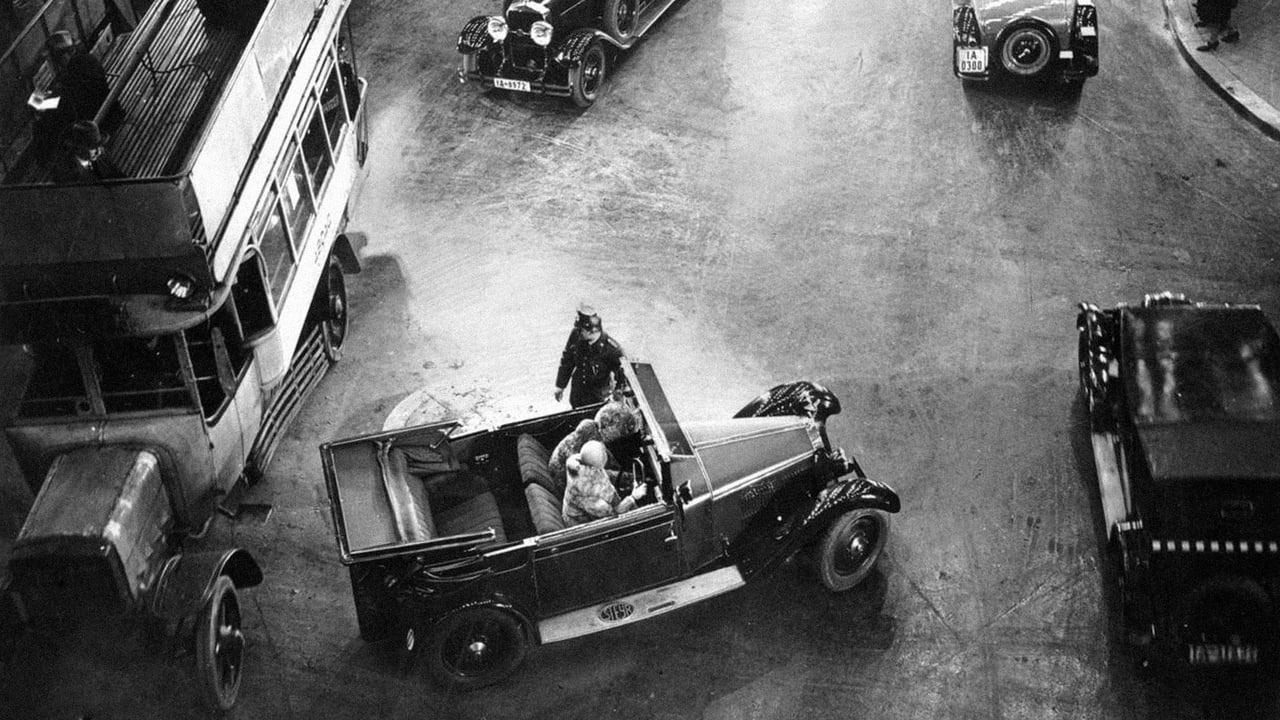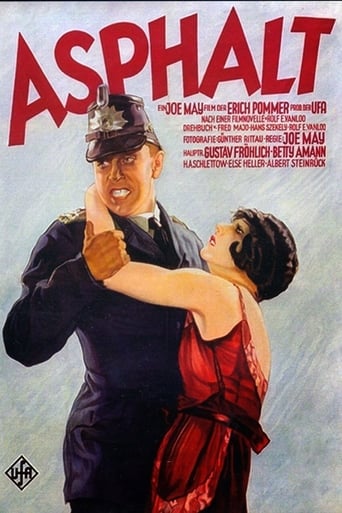

Its hard to like 'Asphalt' simply because the lead characters are so unlikeable. A policeman who is too weak to stand by his moral compass falls for a seductive jewel thief. The film consists of his attempts to refrain from her seductions, feeling low after his failures, then going back only to fail again. It is fine for half an hour or so (the first half hour is the best), but becomes tedious and quickly loses momentum. It doesn't help that these femme-fatale stories were so overdone already.The most winning aspect of this film is the technical achievements. After a shaky Vertov-esque beginning, it quickly becomes sleek and controlled, very modern. The noir cinematography is typically excellent for the German silents of the time. Despite these virtues however, it is not a story that moves you in any way, except to strong dislike of the characters.
... View MoreBetty Amann plays a pretty lady living in Berlin. However, she is a thief--and a very good one at that. Soon after the film begins, she is caught after she steals a diamond--but the authorities cannot find the stone on her. But, an eager young policeman (Gustav Fröhlich) figures out where she's hiding the diamond and he takes her off to the police station. However, he is quite foolish, as the fast-talking thief convinces him to first stop at her apartment to get her things. Well, one thing leads to another and she seduces him. To her, it's all to get out of going to jail--to him, he's having a crisis as he's betrayed everything he stood for. Where all this goes next you'll need to see for yourself.The film is generally quite good, though there are two minor problems I noticed. The acting was occasionally a bit overdone--though mostly it was quite good. Also, the ending seemed a bit hard to believe--though it was satisfying to watch. So although the film wasn't perfect, the problems were easily forgivable. Interesting and well made.
... View MoreAsphalt (1929) begins stylishly with a city montage sequence and plenty of Germanic-styled subjective point of view shots before giving way to a more subdued, intimate Kammerspiel style. A Clara Bow/Louise Brooks look-a-like (Betty Amann) is shopping for jewelry. The storeowner, entranced by her salacious behavior, does not notice when a handful of diamonds fall to the floor. The woman uses the hollowed out bottom of her umbrella to steal one of the diamonds. She is eventually caught, but pleads poverty, which convinces the shopkeeper not to press charges. However, the arresting officer, played by Gustav Fröhlich, plays by the books and insists on bringing her to the police station. The woman asks if they can go by her apartment for her papers. Once in her apartment the seduction begins full throttle. The entrance into her sexual den is given special treatment with a slow, circular panning shot from the officer's point of view. His resistance is admirable, but not impenetrable. She tries everything, including lying in wait in her bed. When all seems to fail and the officer is about to leave she hops out of the bed and literally jumps into his arms, melting his final resolve with passionate stares and heavy breathing. The theme is a common one in German expressionism: the fall/degeneration of the moral upstanding male at the hands of a woman (Pandora's Box, Blue Angel) or social forces (The Last Laugh, The Last Command, American but Germanic in feel). But May handles it subtly and with an erotic-sexual undertone one finds most strikingly in German cinema of the late twenties (Blue Angel, Pandora's Box, Metropolis, Variety, etc.). The film also reflects social critic Siegfried Kracauer's point on pre-Hitler German cinema about the presence of the weak male figure. The young officer's moral and ethical resolve is broken down by the woman's sexual advances, to the point where he accidentally murders the woman's gangster lover in a fist fight after he returns home to unexpectedly find him there (the murder is shot through a mirror reflection). However, when the policeman returns home and tells his parents, the father, also a policeman, does not hesitate to don his police uniform and arrest his son. In the end, the police officer is exonerated by the woman's guilt of complicity. She is arrested, and the final image sees her walking away along a corridor filmed through a prison-like door. As an historical aside, in an underground scene where city workers lay out asphalt, we see a sinewy camera movement along the ground that foreshadows the similar documentary-like camera movements in Pabst's Kammeradscahft (1931).
... View MoreI wasn't familiar with the work of director Joe May - apart from THE INVISIBLE MAN RETURNS (1940) and the Silent epic THE Indian TOMB (1921), a film I was disappointed by and which I always considered more of a Fritz Lang film anyway - although I had always been intrigued by this one and, now, thanks to Eureka and "Masters Of Cinema", I've managed to catch up with it.From watching ASPHALT - followed, in short order, by SPIONE (1928) and TARTUFFE (1925) - I've reacquainted myself with the peerless craftsmanship of German cinema during the 1920s; indeed, May's film is technically quite irreproachable - particularly his depiction of city-life by night, but also the opening montage (echoing contemporaneous Russian cinema) which forms part of the title sequence. Apart from this, the film's slight but compelling plot later became a staple of the noir genre where a naïve man is embroiled in the sordid life of a femme fatale with tragic consequences (the most obvious example, ironically enough, being perhaps Fritz Lang's superlative THE WOMAN IN THE WINDOW [1944]).In this regard, the film benefits greatly from the perfect casting of the two roles but especially the captivating Betty Amann, who effortlessly exudes sexuality throughout: distracting the elderly owner of the jewel shop with her considerable charms, while casually concealing one of the precious rocks in the tip of her umbrella; seducing the young, inexperienced traffic cop by excusing herself from his presence but, when he follows her into the bedroom, finds she has slipped under the sheets and is waiting for him; when he tries to leave, she literally leaps on him and, by wrapping herself around his waist, making it practically impossible for him not to give in to her. Also notable is a brief pickpocketing scene at the beginning featuring Hans Albers; the rather violent fight between the boy and the girl's elderly associate/lover, when the latter comes back to her apartment and catches them in flagrante, in which the furniture (conveniently held by visible wires) gets literally thrown around the room; the concluding act, then, marked by a number of twists (which lead to a sort of happy ending more akin to Bresson's spiritually-infused PICKPOCKET [1959] than the hard-boiled noirs it inspired), is enormously satisfying.
... View More